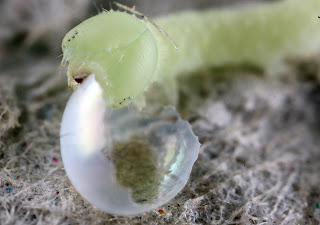What actually emerged a few days later,was this tiny parasitic wasp. In fact, each little egg had the very same occupant. I know that Trissolcus basalis is a parasite of the green shield-bug, but they are so small that I couldn't say with any confidence if that's what we are looking at here.
I decided that a concentrated search for another batch would be in order...
I didn't have long to wait before the tiny bug nymphs began to emerge en-masse...
Click on any photo for a larger view
I also didn't have long to wait to learn something new about the critters...
All 26(?) of them changed from green to brown in a very short space of time. How strange when they would become green once again at the very next stage of development?
Incidentally,isn't it wonderful how symmetric the egg laying is here...rows of 3 then 4 then 5 then 6 then 5 then 4....
They were ready to moult in no time at all and I was lucky enough to be there when a couple did just that...
An amazing thing to witness. Firstly look how large it has already become compared to the exuvia (external skeleton) it is leaving behind. Then see how the insect that is emerging is so pale and almost translucent.
I wanted to show you the large image above because it's such a spectacular thing to see. Here's a set of shots now that give you more of an idea of the emergence process...
Eventually..it breaks free of the old 'skin' completely...
And a shot of it sitting,no doubt exhausted by the effort,beside the Exuvia ...
Does it sound too crass to say that it is quite moving watching something so tiny go through this process that allows it to grow ever larger? It seems a real struggle for the bug and yet-it has no choice,it must undergo this change repeatedly, until it becomes a fully winged adult.
To give you some idea of scale, here's a picture of a freshly moulted one on a corner of an oak leaf... do leaves have corners?
After keeping these just long enough to observe the first moult and then make sure they were all in good health for a few days, I released them and they seem to be doing just fine in my garden.
I'll be back soon with yet another observance first for me that I want to share.
Until the next time then...
Oh! Just before I go...the latest photograph of the poplar hawk moth caterpillar....
Oh! Just before I go...the latest photograph of the poplar hawk moth caterpillar....
What a treat eh?
























